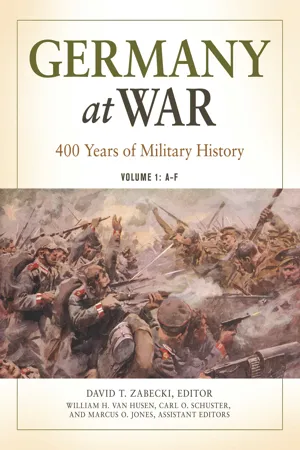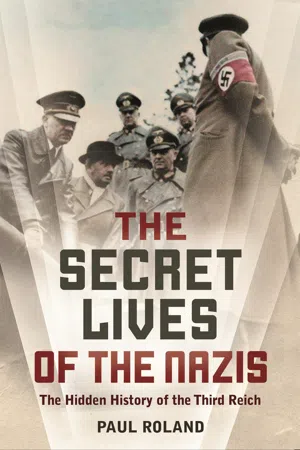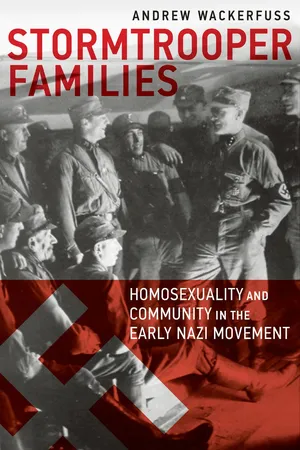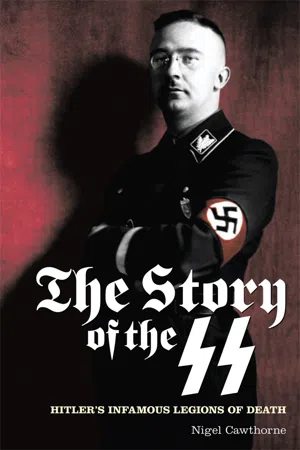History
Night of the Long Knives
The Night of the Long Knives was a purge that took place in Nazi Germany on June 30, 1934. Adolf Hitler ordered the execution of members of the Sturmabteilung (SA), a paramilitary organization that had helped him rise to power but had become a threat to his rule. The event solidified Hitler's control over the Nazi Party and paved the way for his dictatorship.
Written by Perlego with AI-assistance
Related key terms
Related key terms
1 of 4
Related key terms
1 of 3
4 Key excerpts on "Night of the Long Knives"
- eBook - ePub
Germany at War
400 Years of Military History [4 volumes]
- David T. Zabecki(Author)
- 2014(Publication Date)
- ABC-CLIO(Publisher)
Führer ruled alone.Opposition to the Nazis was crushed, and many dissidents were sent to concentration camps. The ubiquitous Geheime Staatspolizei or Gestapo (Secret State Police) kept tabs on the population, but the state was not characterized solely by repression by any means. In the first several years, Hitler was carried forward on a wave of disillusionment with the Weimar Republic, and a plebiscite showed that a solid majority of Germans approved of his actions.On August 2, 1934 Hitler required all German military personnel to swear an oath to loyalty to him personally. Although he was legally the commander in chief of the all the German armed forces as the German head of state, Hitler assumed direct command of the Wehrmacht as its supreme commander in 1938, after he fired minister of war Field Marshal Werner von Blomberg. In 1941, Hitler went one step farther by also assuming direct operational command of the German Army.Almost on assuming political power, Hitler initiated actions against the Jews. They were turned into a race of "untouchables" within their own state, unable to pursue certain careers and a public life. The Nuremberg Laws of 1935 defined as Jewish anyone with at least one Jewish grandparent. That a terrible fate would be their lot was clear in Hitler's remarks that war in Europe would lead to the "extinction of the Jewish race in Europe."In 1934, Hitler took Germany out of the League of Nations and the Geneva disarmament conference. Germans were put back to work; and rearmament, albeit at first secret (it was announced openly in 1935), was begun. Hitler's most daring gamble was in March 1936, when he marched German troops into the Rhineland and remilitarized it. In November 1937, he announced plans to his top advisers and generals for an aggressive foreign policy and war, and in March 1938 he began his march of conquest with the Anschluss - eBook - ePub
The Secret Lives of the Nazis
How Hitler's evil henchmen plundered Europe
- Paul Roland(Author)
- 2017(Publication Date)
- Arcturus(Publisher)
Nazi Germany was Hitler’s psychosis made manifest, a Kafkaesque world of oppressive surveillance and suspicion, of amoral laws enforced by terror, torture and intimidation: one in which children were encouraged to inform on their parents, where the law was used to prosecute the innocent and where no dissenter dared express their thoughts for fear of being dragged off to a concentration camp in the middle of the night without trial, under the criminal decree known as ‘Night and Fog’. But then Nazi Germany was a gangster state run by criminals, psychopaths, sadists and self-serving petty bureaucrats.It was the age of gangsterism, with criminals profiting from an unpopular law (Prohibition) in America and fascist governments exploiting political instability and financial insecurity in Europe, while Stalin presided over a reign of terror in the name of communism in Soviet Russia.Night of the Long Knives
It was not mere competition for the Führer’s favours that fuelled the Nazi leaders’ enmity, but a vicious personal rivalry, one that would mean death for one or more members of Hitler’s inner circle if the opportunity presented itself. For that reason, Propaganda Minister Joseph Goebbels had rushed to Bad Wiessee in Upper Bavaria to be with Hitler on the Night of the Long Knives (the Röhm putsch) on 30 June 1934, rather than remain in Berlin where he feared he might be added to the list of victims being drawn up by Goering and Himmler.It was only after he had satisfied himself that he could still count on Hitler’s protection that Goebbels returned to the capital to coordinate the propaganda campaign that attempted to justify the murder of the SA leadership and dozens of political rivals as a necessary act of ‘self-defence’ by the state.For some months Röhm had been demanding that his Brownshirts should be officially recognized as an autonomous militia and incorporated into the regular army. This was something Hitler could not permit for it would antagonize the army High Command who would then have a legitimate reason to stage their own coup. And so the SA was falsely accused of plotting to overthrow the National Socialist government barely a year after it had seized power. Hitler had prevaricated for some time, reluctant as ever to make a decision when one was needed, and only gave the order when presented with fake documents purportedly written by Röhm, ordering the assassination of his Führer as the first act in the coup. - eBook - ePub
Stormtrooper Families
Homosexuality and Community in the Early Nazi Movement
- Andrew Wackerfuss(Author)
- 2015(Publication Date)
- Harrington Park Press, LLC(Publisher)
10 This threat embodied itself less in organized plans than in daily disruptions, less in formal bureaucratic maneuvers than in spontaneous personal conflicts and rash local actions, as in Bremen. These incidents were local corollaries to the national tensions that bred resentment and distrust of the SA. As citizen complaints resonated up through the Nazi hierarchy, a growing number of military, economic, and political elites joined forces to convince Hitler to put an end to the SA’s independence and arrogance. As long as the SA continued to rage unchecked through the streets, cafés, and public spaces of German cities, their actions would negate Hitler’s claims after July 1933 that the revolution had ended and order had been restored to the German state. Hitler thus needed one last act of violence to secure his claim to order.June 30, 1934: The Night of the Long KnivesTrue to form, Hitler’s eventual decision about the SA settled upon a dramatically violent solution. In June 1934, Hitler directed Röhm to order the SA on a monthlong vacation and promised to attend an SA leadership conference set for June 30 in Bad Wiessee, a Bavarian resort town. The SA vacation distracted SA men and leaders from politics and reduced the chances that they could compare notes and thus uncover the growing plot against them. Röhm’s decision to disperse the stormtroopers to whatever individual destinations pleased them, scattering them across the country and isolating them from their leadership, indicated that the chief of staff had no plans for a putsch.Röhm’s personal circle of high-ranking SA commanders spent the weekend of June 30 at a drunken party at the Pension Hanselbrauer in the Bavarian countryside. A great deal of beer flowed all that Saturday evening, and at least two SA men paired off to enjoy each other’s company in private.11 Around 6:30 am, however, Hitler and a column of SS men arrived at the hotel. According to the diaries and memoirs of several men who were either present at the event or who heard Hitler’s version of the tale firsthand, the Führer and his SS vanguard quietly approached Röhm’s hotel room. Hitler knocked on the door and said in a disguised voice, “Message from Munich.” Röhm, lying in bed undressed, replied that the door was open and the messenger should come in. Hitler then burst through the door, flew into the room, and grabbed Röhm by the throat, screaming, “You are under arrest, you pig.” An SS guard threw Röhm’s clothes into his face and ordered him to get dressed. They then led him out of the hotel at gunpoint, dressed only in his pajama bottoms. Meanwhile, the attackers stormed another room to find Edmund Heines, the SA leader of Breslau, in bed with his 18-year-old driver. Later legends told that the SS men, on Hitler’s personal orders, summarily shot both Heines and his young companion.12 In reality, they took Heines to a prison in Munich and shot him there. The identity and fate of the young stormtrooper remains unknown.13 - eBook - ePub
The Story of the SS
Hitler's Infamous Legions of Death
- Nigel Cawthorne(Author)
- 2012(Publication Date)
- Arcturus(Publisher)
Chapter Three The Night of the Long Knives Although Hitler had seized dictatorial power in 1933, he realized that his position was not secure. Most of all his position was threatened by the SA, led by his old friend Ernst Röhm. However, with a force of over 3 million men, the SA could well have absorbed the much smaller German army, which would have made Röhm its overall leader. That was why Hitler had to act, and act quickly he did. Hitler was aware that power was linked to money. He was already funded by a group of wealthy businessmen and industrialists, who had supported him for fear of a communist takeover. But they were uneasy about Röhm’s revolutionary views and would be glad to see him ousted. Added to that, a number of Party members disapproved of the fact that Röhm and some of the other SA leaders were homosexuals. The SA was a penniless, disruptive force that threatened Germany’s economic stability and Hitler’s own position. A ruthless move against the organization would not only remove a thorn in his side but it would also cow all of the remaining opposition. And the SA could then be blamed for all of the Nazi Party’s previous excesses. Hitler already had the perfect weapon to hand in the shape of the SS, who had already proved their unswerving loyalty. However, the dictator still hesitated. Röhm was the only one of his political associates that he could call ‘ du ’, the familiar form of address in German. Although Himmler and Göring constantly played on Hitler’s sense of insecurity by supplying him with false information about Röhm’s planned coup, any remaining doubts were removed by Röhm himself. On 28 February 1934, the SA leader made a speech in which he declared that the SA was the true army of National Socialism and that the Reichswehr should be demoted to the status of a training corps. It seemed clear that Röhm was angling to become the new Minister of Defence
Index pages curate the most relevant extracts from our library of academic textbooks. They’ve been created using an in-house natural language model (NLM), each adding context and meaning to key research topics.
Explore more topic indexes
Explore more topic indexes
1 of 6
Explore more topic indexes
1 of 4



